
Startups don’t turn into unicorns — the buzzword for companies valued at a billion dollars or more — without a good story attached. For WeWork — which leases office space, divvies it up into desk-sized chunks, and rents it out month to month, largely in fashionable cities like San Francisco and New York — the narrative revolves around catering to a new generation of young workers who want to be creators and collaborators, not office drones. It’s that promise of personal fulfillment that allows CEO Adam Neumann to claim that his company’s short-term subleases are "changing the way people work.” Business is going so well that soon, the five-year-old company expects to change the way people live, too, by offering shared residential micro-apartments under the brand name WeLive.
Investors are bullish on the tale. The company has raised $1 billion in less than half a decade, and its valuation has grown commensurately. In February 2014, WeWork’s financiers said it was worth $1.5 billion. In December 2014, a new set of financiers pumped that number up to $5 billion. Half a year later, most of those same investors injected another round of funding that doubled WeWork's valuation to $10 billion. At that price, WeWork is one of the most valuable startups to emerge from the tech boom, more valuable on paper than Slack, Draft Kings, Lyft, 23andMe, and Warby Parker combined.
Even in a technology cycle whose “defining characteristic” is mega-financing rounds — where investors pour hundreds of millions in funding into a company on the chance that it will be worth billions — WeWork's rapidly multiplying valuation (an appraisal of a company's worth by its investors) has perplexed and alarmed observers. The New York Times, the Wall Street Journal, and even random bystanders on Medium have scratched their heads wondering how free beer and flexibility could add up to a $10 billion business model. “Believe It” read Wired’s dubious headline about the company’s $5 billion valuation last year. Writing in the Commercial Observer last month, Charles Clinton, CEO of the real estate investing company EquityMultiple, called it “perhaps the most polarizing recent valuation … many [real estate] industry insiders find the gaudy valuation to be completely insane.” CompStak, the commercial real estate database, said it felt compelled to investigate WeWork’s margins, because “[l]ike many in the CRE industry, we were curious to understand the math behind WeWork’s fast growth.”
Neumann likes to present WeWork as a star of the sharing economy, a technology platform that connects consumers to office space, just like Uber and Airbnb connect them to cars and homes, respectively. But how can an infrastructure-dependent real estate venture scale like a low-overhead software startup? How can a company that signs 15-year leases — but sells monthly memberships — expect to survive a downturn? How can an entity that doesn’t own its own real estate be “worth” more than three times as much as the New York Yankees? Why does WeWork’s future look so bright when it sits smack in the middle of two bubbling markets (that is, tech and commercial real estate)? Why would a business model that drove one high-profile dot-com darling promising “the office of the future” into bankruptcy succeed this time around?
October 2014 fundraising documents obtained by BuzzFeed News reveal how Neumann answers those questions behind closed doors. The material was shared with BuzzFeed by someone familiar with the company, on the condition of anonymity, and independently verified. WeWork would only comment on a couple of aspects of its fundraising pitch. It includes a five-year financial forecast and a slide presentation (also known as a pitch deck), both embedded below, as well as a company overview. After reading these documents, investors such as Goldman Sachs, Harvard University, and JPMorgan handed WeWork $355 million in funding, along with the $5 billion valuation, as part of its Series D funding round in December 2014.
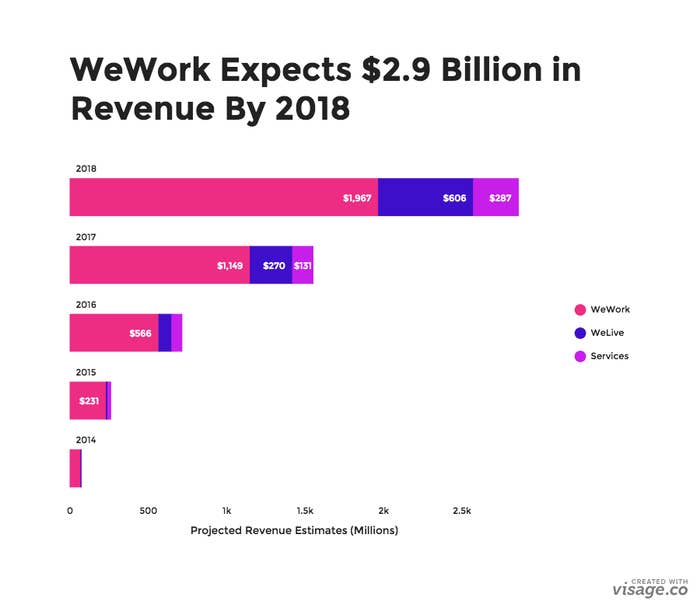
WeWork expected operating profit of $4.2 million from revenue of $74.6 million by the end of 2014. By 2018, the company predicted operating profit of $941.6 million on revenue of $2.86 billion. The number of co-working members were to set to explode from 16,279 to 260,000 in the same time period. WeWork forecast 376 shared office location in 2018, up from 24 in 2014.
This material was prepared a year ago. Since sharing this data with investors, WeWork has raised yet another $433 million (mostly from the same firms). In the interim, its predictions have changed significantly, as have some of its business practices. So these documents are less useful as a peek into WeWork’s current financial state than they are as a snapshot of a high-profile company on its way up (and up, and up) in a moment when investors are flush with cash and open to any company with the faintest veneer of technology, if it sounds like the upside is Uber-sized. Indeed, if these documents tell us anything, it’s that WeWork has mastered the kind of storytelling that locks down massive rounds and can earn what is essentially a real estate company the privilege of being discussed as — and valued like — a nimble Silicon Valley software startup.
The story is a good one. All told, the fundraising documents portray a company on a phenomenal trajectory. Profits, membership, and locations grow at an enviable rate, while occupancy hovers just below 100%. But the material also reveals that WeWork relied on enormous demand projections and certain accounting tricks — both of which are popular tactics among private companies — to keep its profit margins looking as high as its aspirations.
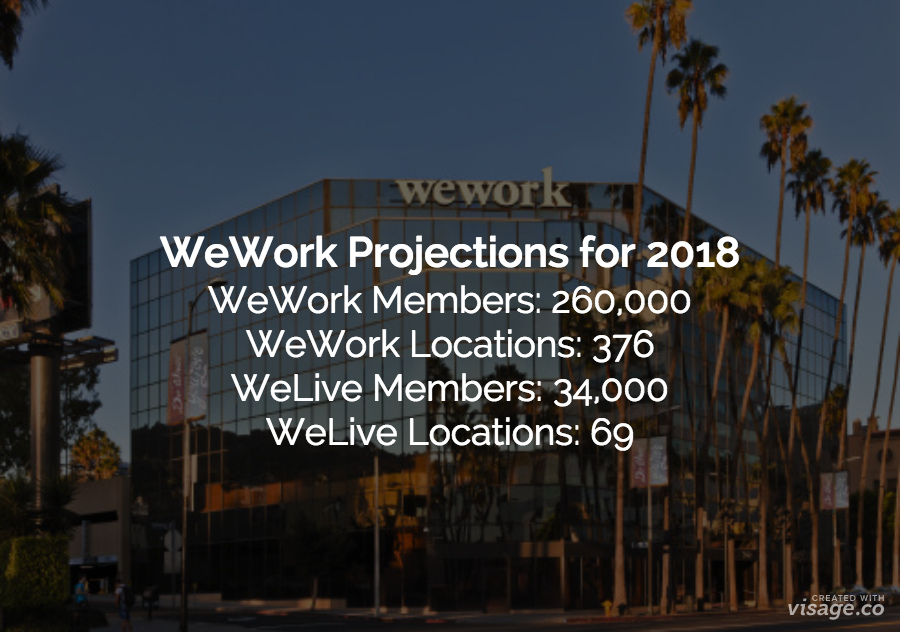
None of this is unique to WeWork — that’s precisely the point. Its business model is atypical for tech, but the economic and cultural practices that made it a $10 billion company pervade Silicon Valley. To its detractors, at least, WeWork is the poster startup of a funding climate fueled by FOMO and driven to extremes, where valuations can double in a matter of months and where investors who are so “desperately afraid” of missing out on the next unicorn will slap a horn on a horse.
But like most private companies, WeWork publicizes only metrics that paint the company in a better light, so skeptics have relied on back-of-the-envelope math and gut-level instinct. WeWork’s presentation (published for the first time below) is perhaps our best clue to understanding how startup valuations get made. It offers a glimpse into the deal-making behind a “decacorn” — the latest Silicon Valley jargon for a $10 billion company, and another term that gets tossed around with little irony about the kind of magical accounting it may take to conjure up so many mythical beasts.

The Information first reported some of the financial data in these documents in late August, highlighting WeWork’s use of accounting practices that make rent look lower in the near-term and shove off expenses further down the line. Ultimately, The Information concluded that these practices could make its forecast "tough to meet.”
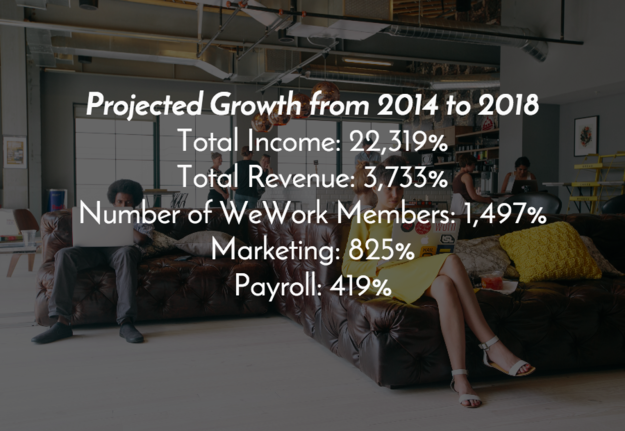
“They have extraordinary, hockey stick–like projections,” Eric Sussman, senior lecturer of accounting at UCLA’s business school and chair of the investment management firm Causeway Capital, told BuzzFeed News after being shown the documents. “Which in and of itself is not uncommon. But they seem very, very aggressive.”
Fundraising documents are designed to dazzle. Investors spend only three minutes and 44 seconds on average flipping through a pitch deck, so companies have to make the future look big and bright. In fact, a WeWork spokesperson told BuzzFeed News that when it's time to actually cut the check, "our large institutional investors have access" to "audited financial statements." In other words, investors are shown two presentations: one that uses standardized accounting practices and one that doesn't.
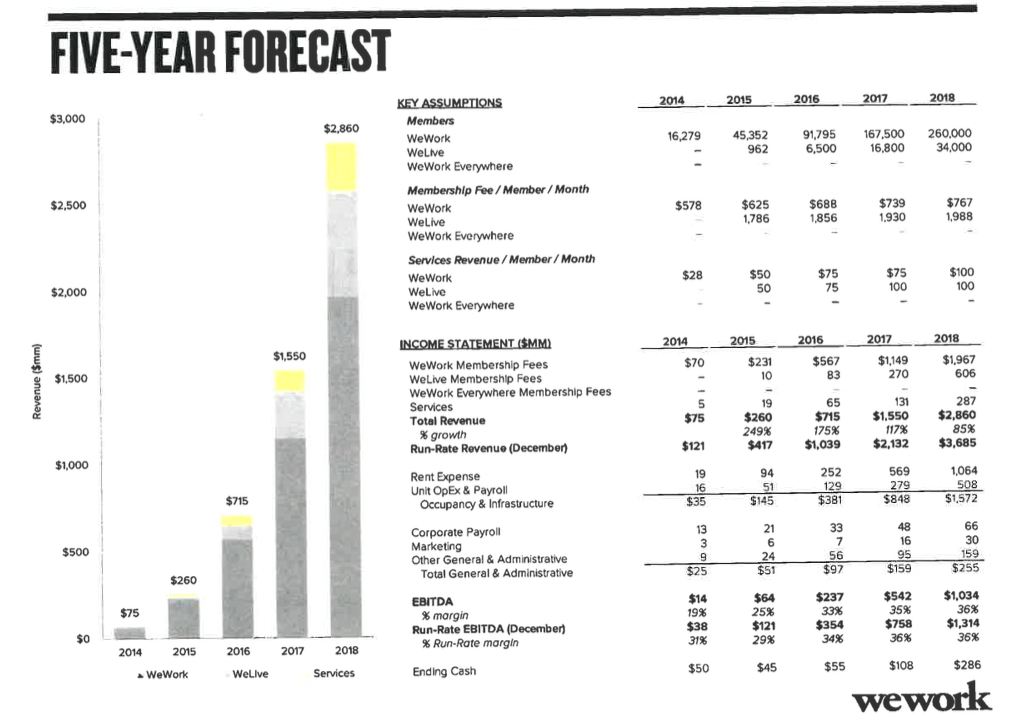
But the initial presentation gets them into the funding groove. "It's the best deck I've ever seen!" one tech executive told BuzzFeed News, jokingly referring to the optimistic projections in slide after slide of WeWork’s pitch.

Here’s how WeWork works, according to the documents: The company doesn’t own real estate, but instead takes long-term leases in centrally located neighborhoods in gateway cities. So in order to make a profit, it has to charge members more than it pays landlords. WeWork is relying on additional revenue from raising office rents, selling services like health care, collecting commissions off its real estate deals, and signing people up for its co-living product.
WeWork started leasing office space in 2010, when the commercial real estate market had yet to rebound after the 2008 financial crisis. Now that the market is hitting record highs, WeWork is pursuing a different strategy: negotiating with landlords for considerable concessions. These concessions, detailed in the 2014 documents, include reduced rent, periods of free rent, and infusions of up-front capital to build out and refurbish locations. In exchange, the documents state that WeWork would share 25 to 50% of its profits with landlords, and take longer leases than is normal. WeWork refers to these profit-sharing deals as “asset light,” in both the fundraising materials and in the press, but their weightlessness is debatable. CompStak analyzed 21 of WeWork’s leases in New York City and found that 17 lasted more than 15 years, including six leases signed in 2015.
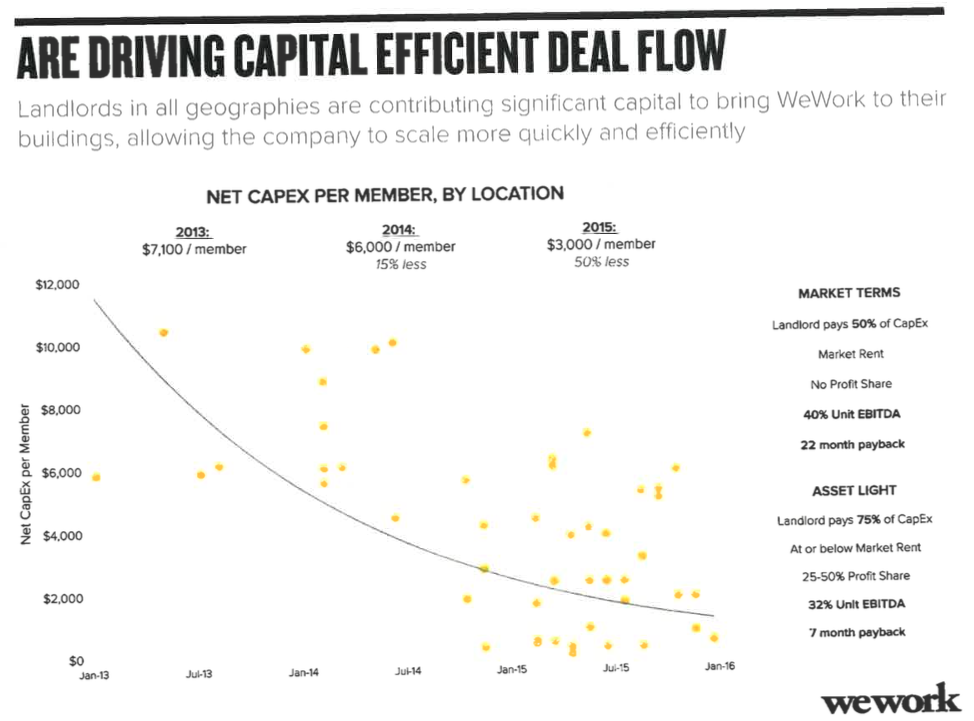
(WeWork has since pivoted away from the profit-sharing aspect or below market rents. "Asset light" now means the company get about 75% of the cost of build-out covered by the landlord, but WeWork keeps the upside. Landlords have been willing. That’s the nice thing about a billion-dollar price tag — it opens a lot of doors.)
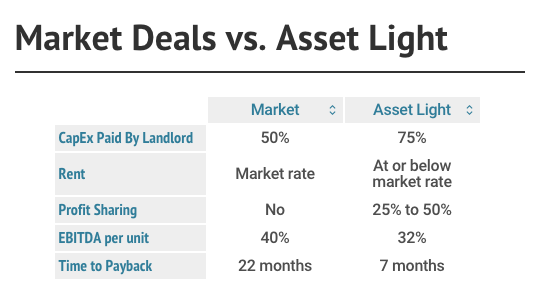
In WeWork’s financial forecast, concessions like free rent are not stated using standard accounting practices (GAAP), which call for the discounts to be divided up over the length of the lease. WeWork instead accounts for it all at the beginning. And when the free rent ends, expenses go up. WeWork’s extra-long leases and number of new leases mean that even a five-year forecast won't show potentially significant jumps in cost. This accounting strategy gives WeWork “higher income projections in the early years” of a location, as David A. Kessler, national director of commercial real estate for the accounting and advisory firm CohnReznick, told BuzzFeed News. The same principle follows for other concessions: Landlords fronting the cost of building out a location make WeWork’s initial costs appear artificially low.
Relying on optimistic numbers is de rigueur for startups. For example, WeWork’s documents also make frequent reference to EBITDA — a financial initialism meaning Earnings Before Interest, Taxes, Depreciation, and Amortization — which, according to Sussman, is commonly “used in banking and valuation, but you won’t see that term or figure in audited financial statement.” Private companies are not obligated to use GAAP, and the vast majority of startups avoid those rigorous standards until an initial public offering exposes them to SEC oversight. Moreover, while investors are still unicorn-hunting, companies like Uber can keep raising massive funds from the private market, saving themselves from the scrutiny of Wall Street, which tends to obsess over numbers.
WeWork's unique financing deals are great for cash flow, Kessler explained: WeWork is simply using landlords to help while it builds up a revenue stream. Yet despite increasing costs, WeWork forecasts that its margins will rise, relying on a massive growth in members and a bump in the amount that those members will pay. Kessler pointed to rising revenue per square foot — an increase he called “unusual.” The company further boosts its margins by predicting that its marketing and payroll costs will dwindle as a percentage of revenue — despite its ambitious expansion and a growing number of smaller competitors. Sussman pointed out that even a popular company like Netflix will have to spend more to get "that 50 millionth American."
Essentially, Kessler said, “[WeWork] must believe that demand will continue to increase in order to drive the rates.”
But WeWork can't predict demand. Valuations are a story about the future — and no one knows what the future holds. Even the most iconoclastic Silicon Valley companies are still lined up against their competitors in order to estimate future potential. In WeWork’s case, that’s Regus, a publicly traded corporation that lets tenants make temporary offices look like traditional ones; WeWork claims its unit margins are 44%, compared with 16% for Regus. But the two companies are peers only in the broadest sense of shared office space. Regus, which went bankrupt in the year 2000, is not a name brand. Regus isn't 'roided out with a $1 billion investment, and no one’s wearing Regus-branded T-shirts or going to Regus summer camp — which is partly why all of the experts BuzzFeed News consulted had a hard time assessing whether WeWork’s margins were sustainable.
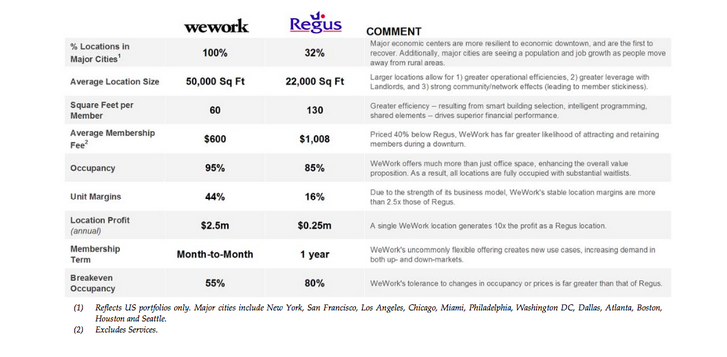
“What happens when your whole business model is based on being hip and you’ve got to re-hip it?” Steve Weikal, head of industry relations for MIT’s Center for Real Estate, asked BuzzFeed News. “You’re supposed to be at the leading edge of cool, and what’s the cost? I doubt that landlords will be paying for that the next time around.”
WeWork argues that it has a number of “global macro trends” working in its favor, including an increasing percentage of the workforce going freelance, and the shrinking usage of corporate real estate.
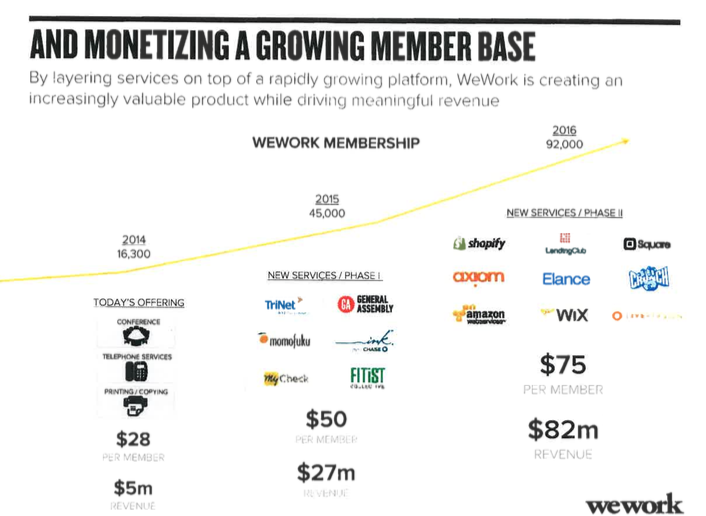
"Commercial real estate is a very large asset class, it is highly fragmented and predominantly caters to larger companies,” a WeWork spokesperson told BuzzFeed News. "Today's modern workforce is increasingly independent and has fundamentally different needs, with a preference towards flexibility and a willingness to share space and services. They also enjoy the social and business benefits of being part of a broader community which WeWork offers."
WeWork’s vision for what will happen to these trends in lean financial times is sunny to the point of blinding. In the slide below, WeWork expects its occupancy in a downturn to dip to 85%, which is what Regus gets in a good economy.

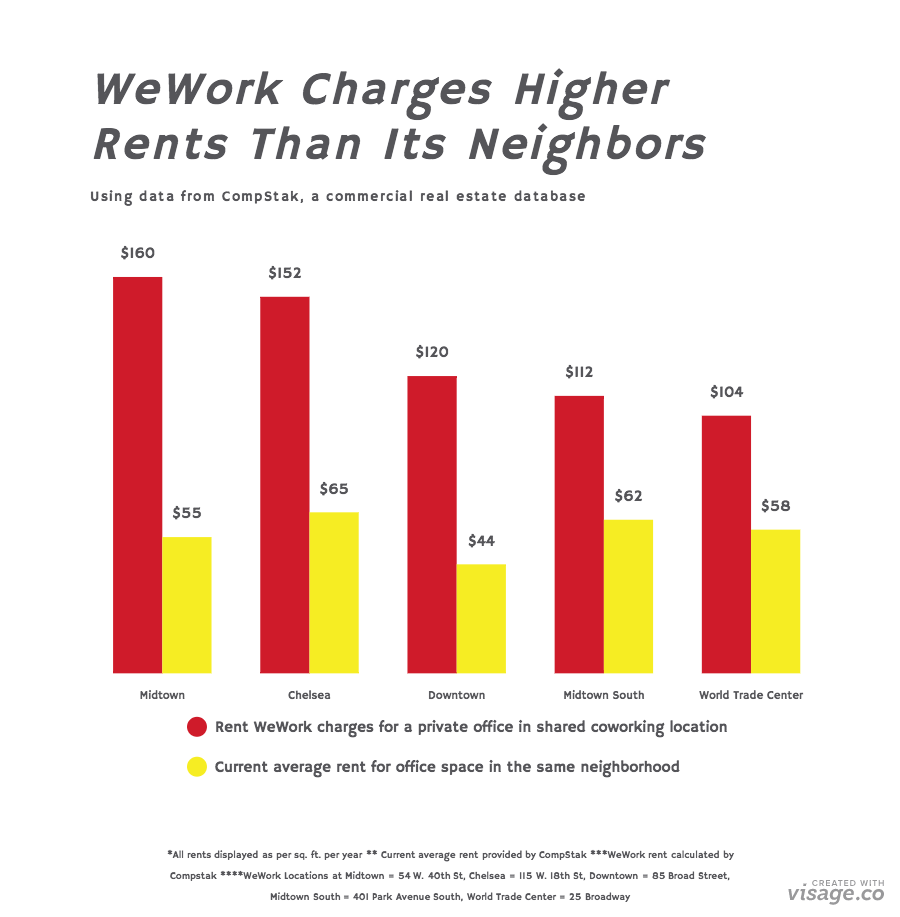
At face value, WeWork should evaporate when the tech bubble bursts because its co-working spaces are filled with tiny startups that will eventually either run out of funding or return to the coffee shops and home offices from whence they came. The company counters that it’s diversified into industries beyond tech and brought on larger tenants, who will want to downsize if times get tough. WeWork also insists that it will retain “cost-conscious members,” pointing out that it launched in a downturn. But back then, competition offering the same sleek aesthetic was slim. Now venture capitalists are contemplating raising their own real estate fund for live/work spaces so investment dollars can’t be siphoned off by WeWork.
All these vagaries are what make the cash flow statement (below) so crucial, said Sussman. “It’s the holy grail, the ‘show me the money’ financial statement.” For example, WeWork would have ended 2014 with a net negative cash flow of $78 million if not for a $101 million infusion of capital. That’s not a bad thing. “Growing companies usually bleed money,” Sussman said.
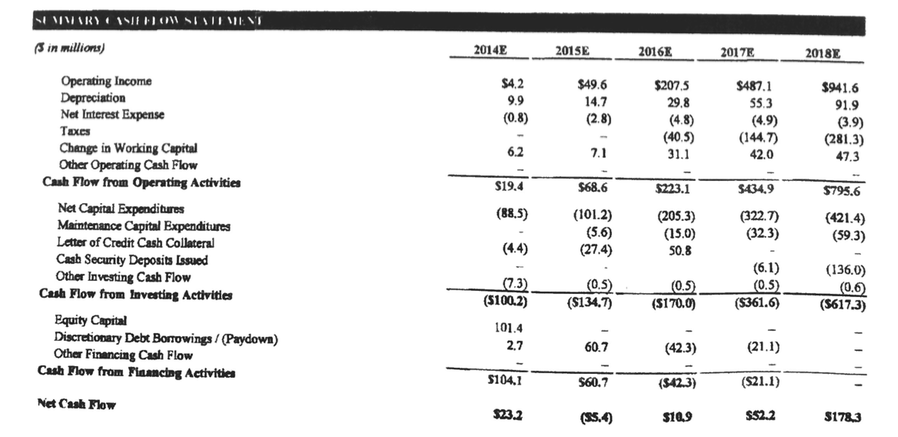
Indeed, the fundraising documents were quiet on the question of present-day profitability (WeWork’s operating profit for 2014 was a slim $4.2 million), looking at unit economics instead. Take this impressive slide about WeWork’s “Proven, Profitable Business Model.”
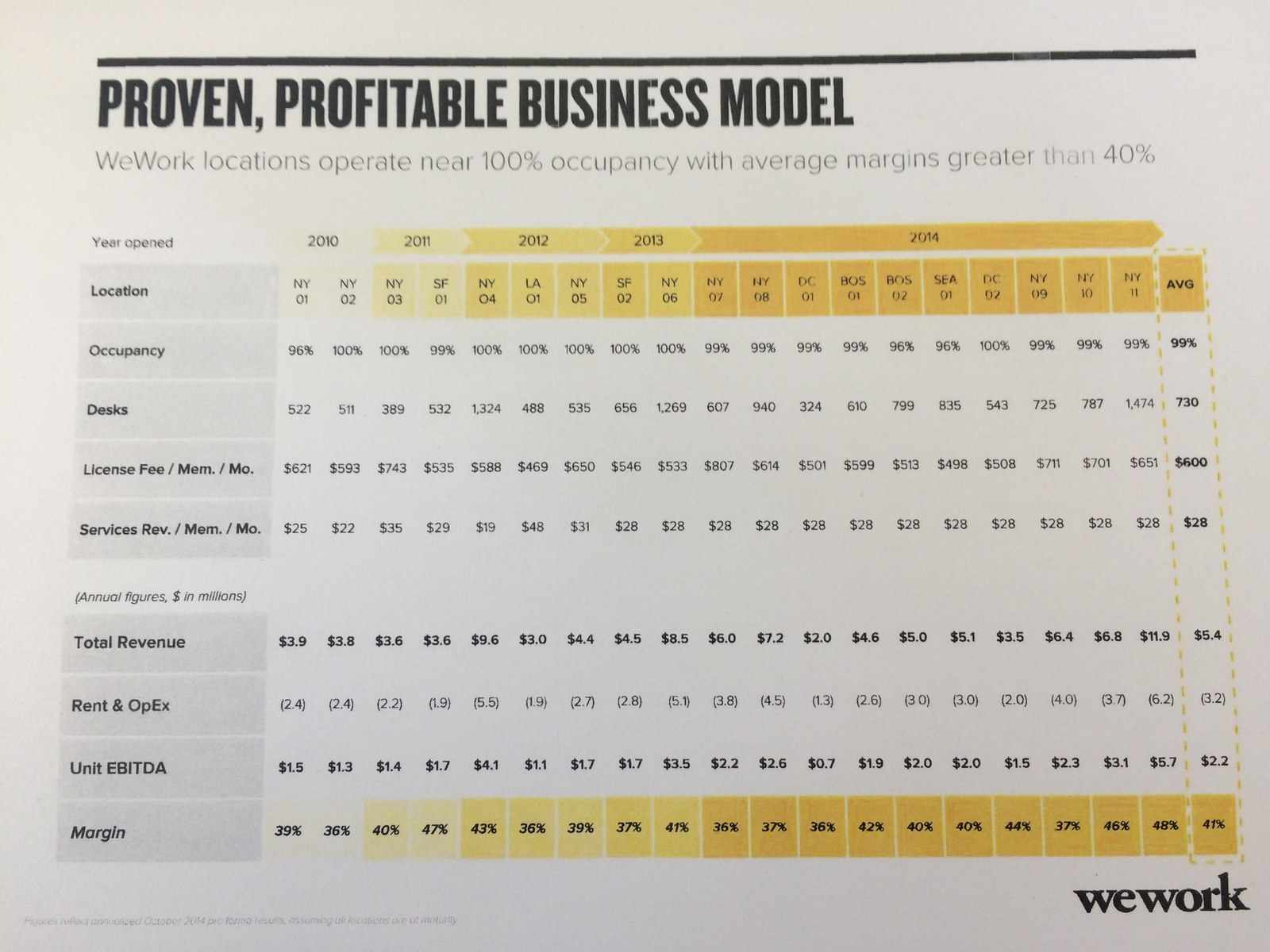
Profits look less certain when you read the fine print: Each location is shown “at maturity,” even though almost half launched earlier that year, which likely means that WeWork didn’t factor in the initial costs of construction and development.
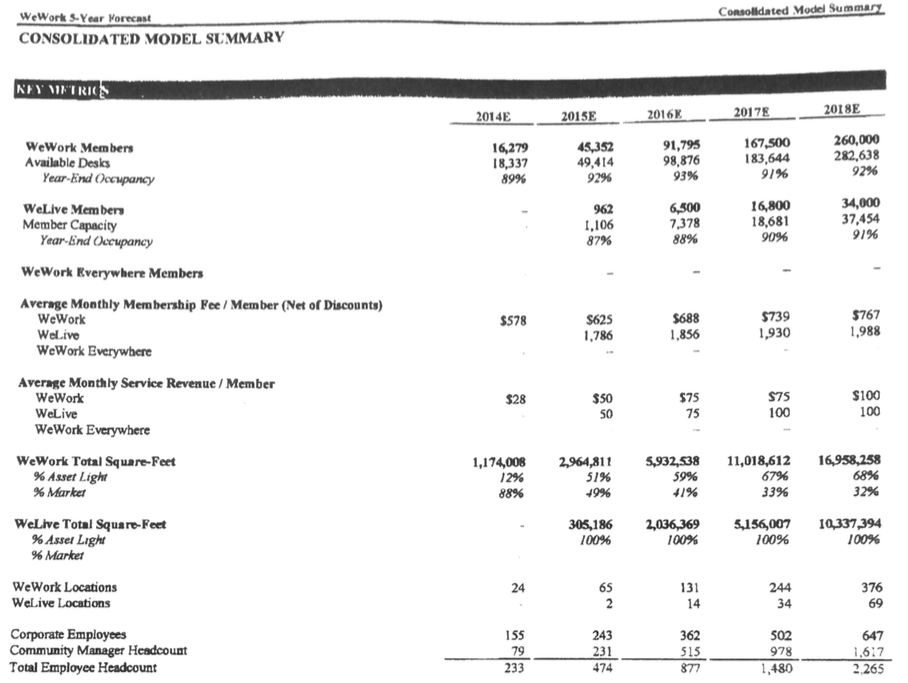
These slides show how easy it is to create a good-looking growth curve — not just for WeWork, but for all of its peers in the current tech climate. “You put together a model. It spits out whatever it spits out based on the inputs,” Sussman told BuzzFeed News. “I always say, ‘If you gave David Copperfield or Harry Potter Microsoft Excel, they could do even more amazing magic.’" The basis for WeWork’s five-year forecasts, he said, all rests on its assumptions. "Key metrics like membership growth, pricing, and square footage leased drive the whole model. Change those inputs and everything changes." Input in, pivot out.

According to the documents, WeWork’s biggest gamble of all appears to be WeLive, the company’s upcoming leap from office to home. Two sources familiar with the company’s business plan told BuzzFeed News that Neumann tells his investors that co-living will one day be a bigger part of the business than co-working.
A big reveal like that is part of the show. "It's a bit of a trope," one tech company executive told BuzzFeed News. "Investors want to hear a story," so founders know to frame current plans as merely the beginning. "What's bigger than working? Living!" the executive explained.
According to the documents, WeLive is expected to supply 21% of the company’s overall revenue by 2018 — even though it has yet to launch — and bring in $605.9 million in annual revenue three years after its debut. Locations were slated to open in October and November, but a source close to WeWork says it was pushed to the end of the year.

Much like WeWork’s office-rental arm, projected earnings from co-living depend on a steady stream of customers willing to sacrifice privacy for proximity to like-minded people.
Part of that calculation is premised on the idea that WeWork is cheap: WeLive promises 36% savings on annual housing costs. But its micro-apartments may actually be more expensive than their nonbranded counterparts. Monthly rent in Manhattan’s Financial District (the site of the second WeLive location) is $5 per square foot, according to the real estate database Zillow. Based on WeWork’s forecast, which lists 276 square feet per available bed, WeLive tenants could pay $6.5 per square foot in 2015 and up to $7.2 per square foot in 2018. The price goes up if you include WeLive’s “services” fee, which is set to double to $100 a month by 2018. The company would likely argue that price per square foot doesn’t factor in shared space like a rooftop lounge, but that’s a tough sell when more millennials are moving back in with their parents even as the job market improves.
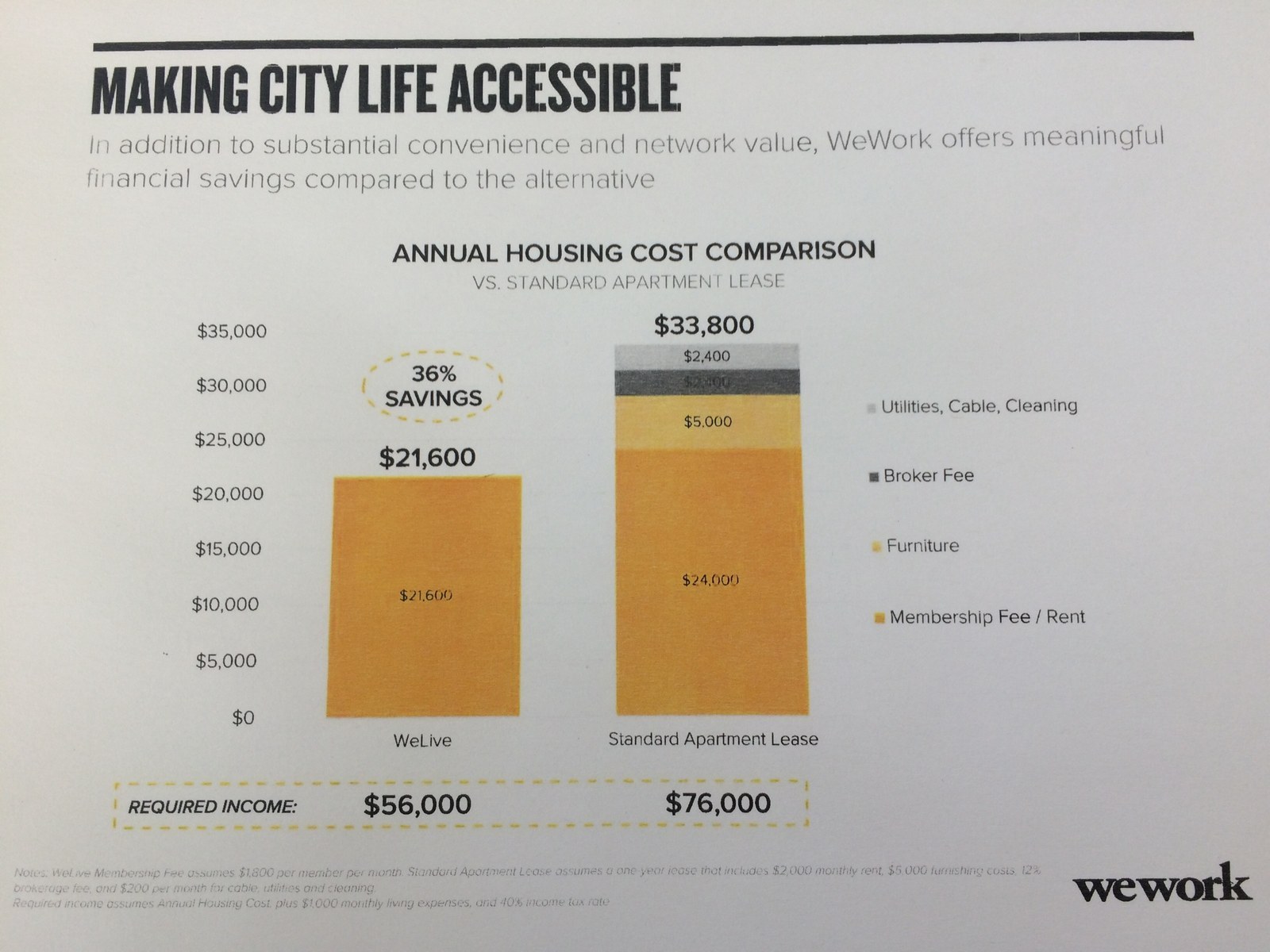
WeWork’s cost-effectiveness claim is debatable for its office space as well. The company says it saves tenants 25% on a standard office lease, once you factor in cleaning, internet, and convenience, but the markups add up. Its starter package of $45 a month buys one day of free desk space per month and charges $25 an hour for conference rooms as well as $50 a month to use WeWork as a business address. The hourly price for conference rooms increases during peak hours, just like Uber cars.
Tenants are well aware that it's "scandalously priced" per square foot, but an on-demand office is worth it for entrepreneurs who want to "Do What You Love," as WeWork's neon sign says.
That may be why WeWork’s investors are nonetheless on board for Neumann’s grand plan, one source told BuzzFeed. Financiers in search of the next big thing still think there’s an untapped market of apartment renters who care less about personal space and more about the perks of a built-in social network. “I’d live in a living room with just a kettle and a fridge if I could use a big kitchen sometimes,” one tech investor (who has not funded WeWork) told BuzzFeed News. The investor thinks that the idea of a “rich guy commune” will be huge — “but, hey, I’m single.”

In July, venture capitalist Bill Gurley wrote a blog post about why pitch decks rule. His top reason was the "importance of narrative." “Investors are not solely evaluating your company’s story,” he said. “They are also evaluating your ability to convey that story.” If you can convince Goldman Sachs that micro-apartments are the next Snapchat, you can convince freelancers to pay $450 a month for a desk, and then you can convince Coca-Cola that it really needs to start co-working next to these creators.
There’s a formula to the narrative Gurley and the rest of his industry reveres. Your destruction target should be framed as a stodgy industry just aching to be upended by increased efficiency. Your company should appeal to coveted customers, such as young people and/or citizens of the developing world. It should swear that it can scale on software alone (that’s why Uber insists it’s not in the transportation businesses — even as it develops driverless cars). And your narrative should impel would-be investors to look away from short-term profitability and instead gaze upon the mammoth size of the potential market (often one of the more cringeworthy slides in most pitch decks.)
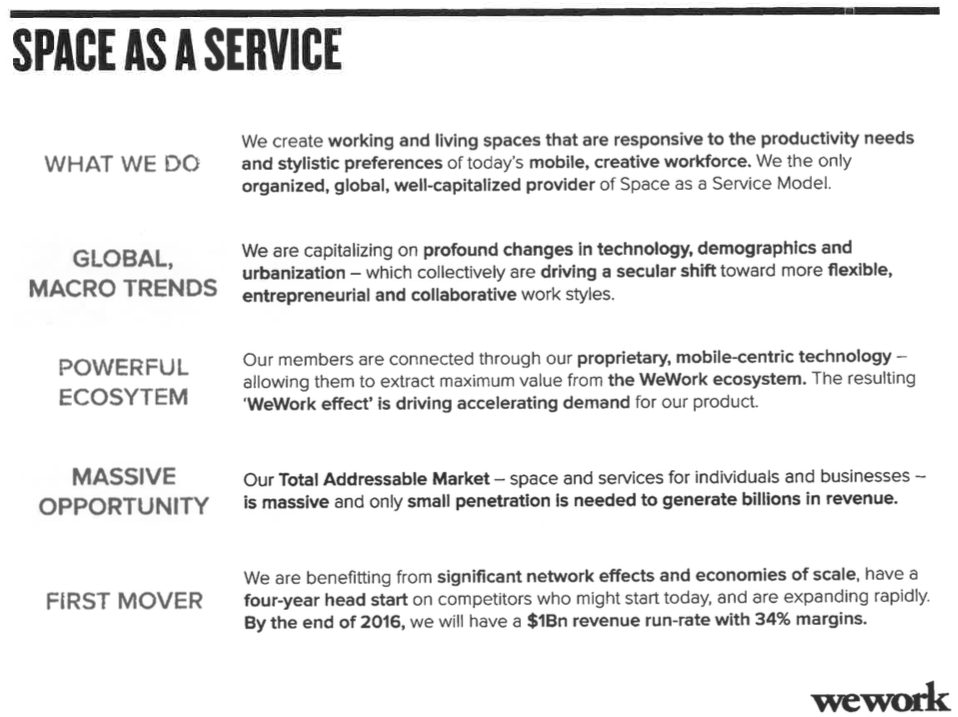
The framework of WeWork's fundraising documents fits the formula perfectly. "MILLENNIALS ARE REDEFINING THE WORKFORCE,” the company proudly shouts at the beginning of the deck, with references back to its tech-savvy user base throughout. In one slide, WeWork describes itself as “space as a service,” a play on software-as-a-service companies like Salesforce. WeWork also refers to itself as a subscription model — basically anything but Regus. And just as Uber won hearts and minds by proving that demand for its service is not limited to the size of the taxi market, WeWork says it can get $1 billion in annual revenue with just 1% penetration in key cities — but a closer look reveals that WeWork has a very broad definition of potential customers: every single company with up to 100 employees in “industries that use office space” and 20% of companies that have 100 to 5,000 employees.

WeWork can make a credible claim to all these characteristics, but the story is so compelling because we’ve been watching it (occasionally) come true — and no one ever got mega-rich on a safe bet. WeWork’s ability to graft this formula onto office space subleasing may have baffled real estate insiders, but by punctuating its pitch with buzzwords like “sharing economy” and “asset light,” the company has been able to hide out in the “startup” sector.

A company’s valuation is often calculated based on a multiple of its earnings. Tech startups command much higher multiples, because building and shipping software is relatively cheap and easy compared to making physical products. (That’s part of why WeWork calls itself a tech company and not a real estate company.)
To figure out a fair multiple, investors look at how competitors are valued — which may be why one of WeWork’s board members is fond of comparing it to Chipotle and Uber. Based on operating income from 2015, WeWork’s $5 billion valuation was 100 times its earnings. That matches what Neumann told the Wall Street Journal in December. Since then, WeWork has more than doubled from 23 locations to 52, but that multiple is still stratospheric: Office-space landlords often trade at a multiple of 18 to 20 times earnings, and Regus trades at around 13 times operating income.
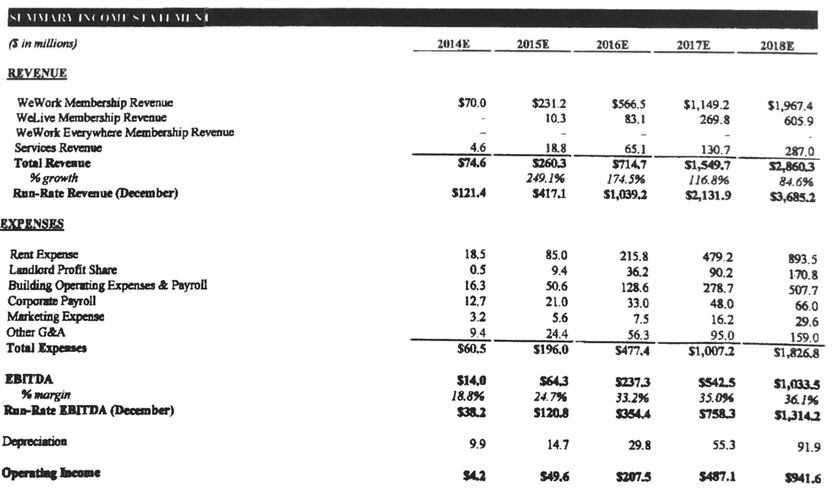
It’s not all froth and games, of course: When you’re growing at hyper-speed, current results offer a clearer picture of potential. Real estate investors, for example, pay more attention to cash flow because it reflects what a company will be able to generate. But in order to bring those multiples down to earth, it’s common practice to include puffier metrics.
In December, law professor and author Steven Davidoff Solomon wrote that investors have been willing to play along with aggressive assumptions just to secure “the privilege of investing” during the “frenzy to find the next Uber” in which companies are “priced to perfection.” Solomon name-checked WeWork as an example of this trend. “These companies may have ideas that work,” he argued. “But more likely, everyone is overestimating market share and pushing assumptions.” In other words, WeWork and its cohort of decacorns could find successful business models and still not grow into their valuations.

Potentially misleading financial metrics were a hot topic this summer. In June, the Wall Street Journal reported that startups were playing “the numbers game” by sharing inflated stats that “far exceed actual revenue,” only to deflate once the company goes public or is forced to abide by SEC standards. The practice got so out of hand that the venture capital firm Andreessen Horowitz and Sam Altman, president of the incubator Y Combinator, simultaneously felt compelled to issue stern guidelines to startups this summer about financial “misstatements.”
The blame runs both ways. In a February 2015 blog post, Gurley said late-stage investors “have essentially abandoned” traditional risk analysis. “Investors are assuming that the numbers they see in the fund-raising deck are the same as those they might see” in a heavily scrutinized IPO filing, he wrote. Perhaps he was warning his officemates. Gurley’s firm, Benchmark Capital, invested in three of WeWork’s five rounds, including the ones that assumed the co-working company was worth $5 billion and $10 billion.
Aside from Benchmark, WeWork’s recent investors are the late-stage ones Gurley warned about. The $355 million round that WeWork picked up based on the strength of these documents was led not by Silicon Valley, but by Goldman Sachs, T. Rowe Price Associates, and Wellington Management; the other investors participating in that round were JPMorgan and Harvard’s endowment. They may be hungrier for a hot deal after watching a herd of unicorns pass them by. In an analysis of WeWork’s $10 billion valuation, technology analyst Ben Thompson said it made sense for funds like Fidelity, which invested in WeWork’s last round, to earmark “a fraction of a percent of their cash” toward “building a unicorn portfolio.” Mutual funds have been investing in startups so aggressively recently that Fortune wondered if it wouldn’t start affecting retirement funds.
Sussman emphasized that Boston Properties and WeWork’s other institutional investors are “very sophisticated.” They likely looked at shifting trends in office space — for example, a decline in the number of square feet reserved for each employee. “WeWork is part of this trend; these guys are trying to buy into it,” said Sussman.
Six months after the funding round from these documents was announced, investors anted up on the trend with another $433 million. In theory, this is how it’s supposed to work. A startup mesmerizes investors with tales of an undiscovered market and financiers keep the company afloat until it dominates this new world. But when funding comes so fast and easy and suffused with so much FOMO, it can sound like investors are buying their way into value as much as buying into a trend. After WeWork was marked with its $10 billion price tag, CEO Adam Neumann told the Wall Street Journal that “a higher valuation with more cash invested by investors just means you need to deliver higher returns.” In other words, sketching out a “grand” vision will only get a decacorn so far. At some point, that story about the future becomes a demand from the present.
